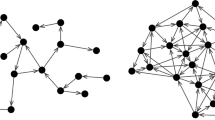Abstract
Terry Horgan and John Tienson have suggested that connectionism might provide a framework within which to articulate a theory of cognition according to which there are mental representations without rules (RWR) (Horgan and Tienson 1988, 1989, 1991, 1992). In essence, RWR states that cognition involves representations in a language of thought, but that these representations are not manipulated by the sort of rules that have traditionally been posited. In the development of RWR, Horgan and Tienson attempt to forestall a particular line of criticism, theSyntactic Argument, which would show RWR to be inconsistent with connectionism. In essence, the argument claims that the node-level rules of connectionist networks, along with the semantic interpretations assigned to patterns of activation, serve to determine a set of representation-level rules incompatible with the RWR conception of cognition. The present paper argues that the Syntactic Argument can be made to show that RWR is inconsistent with connectionism.
Similar content being viewed by others
References
Cutland, N. J.: 1980,Computability: An Introduction to Recursive Function Theory, Cambridge University Press, Cambridge.
Davis, M.: 1982,Computability and Unsolvability, Dover, New York.
Dreyfus, H. and Dreyfus, S.: 1988, ‘Making a Mind Versus Modeling the Brain: Artificial Intelligence Back at a Branchpoint’, in S. R. Graubard (ed.),The Artificial Intelligence Debate: False Starts, Real Foundations, MIT Press, Cambridge, Massachusetts, pp. 15–43.
Fodor, J. and McLaughlin, B.: 1990, ‘Connectionism and the Problem of Systematicity: Why Smolensky's Solution Doesn't Work’,Cognition 35, 183–204.
Fodor, J. and Pylyshyn, Z.: 1988, ‘Connectionism and Cognitive Architecture’,Cognition 28, 3–71.
Garey, M. and Johnson, D.: 1979,Computers and Intractability: A Guide to the Theory of NP-Completeness, W. H. Freeman, New York.
Horgan, T. and Tienson, J.: 1988, ‘Settling into a New Paradigm’,Connectionism and the Philosophy of Mind: Proceedings of the 1987 Spindel Conference, Southern Journal of Philosophy 26, 97–113, supplement.
Horgan, T. and Tienson, J.: 1989, ‘Representations Without Rules’,Philosophical Topics 17, 147–174.
Horgan, T. and Tienson, J.: 1990, ‘Soft Laws’,Midwest Studies in Philosophy: The Philosophy of the Human Sciences 15, 256–79.
Horgan, T. and Tienson, J.: 1992, ‘Cognitive Systems as Dynamical Systems’,Topoi 11, 27–43.
Machtey, M. and Young, P.: 1978,An Introduction to the General Theory of Algorithms, North Holland, New York.
McClelland, J. L. and Rumelhart, D. E.: 1981, ‘An Interactive Activation Model of Context Effects in Letter Perception: Part I. An Account of Basic Findings’,Psychological Review 88, 375–407.
McClelland, J. L., Rumelhart, D. E. and the PDP Research Group. (eds.): 1986,Parallel Distributed Processing: Explorations in the Microstructure of Cognition, Vols. 1, 2, MIT Press, Cambridge, Massachusetts.
Rogers, H.: 1987,Theory of Recursive Functions and Effective Computability, MIT Press, Cambridge, Massachusetts.
Rumelhart, D. E. and McClelland, J. L.: 1982, ‘An Interactive Activation Model of Context Effects in Letter Perception: Part 2. The Contextual Enhancement Effect and Some Test and Extensions of the Model’,Psychological Review 89, 60–94.
Smolensky, P.: 1989, ‘On Variable Binding and the Representation of Symbolic Structures in Connectionist Systems’, Technical Report CU-CS-355-87, Department of Computer Science, University of Colorado at Boulder, February.
Author information
Authors and Affiliations
Additional information
The present paper has been improved by conversations with Terry Horgan and John Tienson. Thanks are also due to Gary Fuller, John Heil, Terry Horgan and Bob Stecker for comments on earlier drafts of this paper.
Rights and permissions
About this article
Cite this article
Aizawa, K. Representations without rules, connectionism and the syntactic argument. Synthese 101, 465–492 (1994). https://doi.org/10.1007/BF01063898
Issue Date:
DOI: https://doi.org/10.1007/BF01063898




